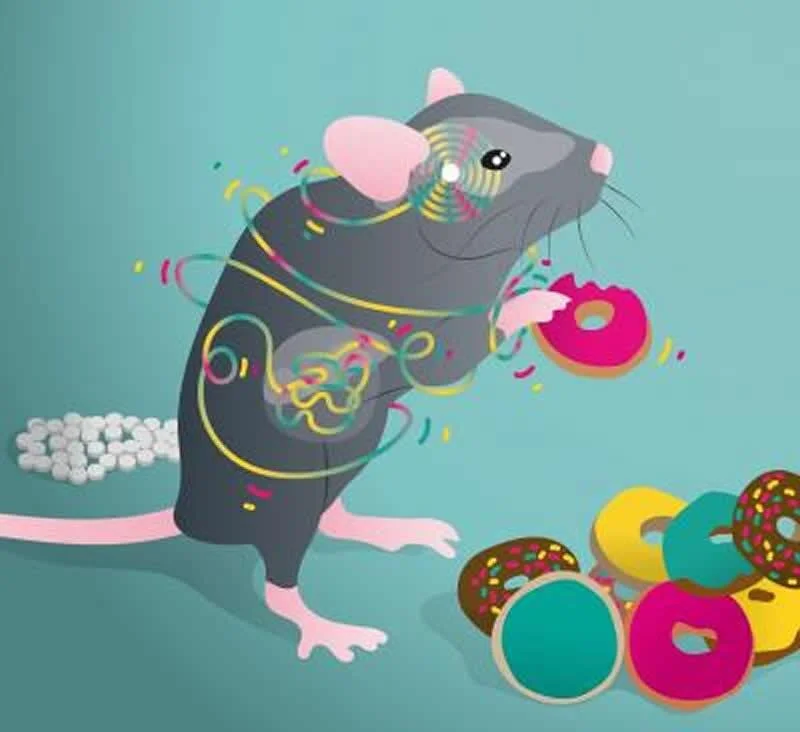In pursuit of understanding the

NEWS
Pyramidal tract neurons drive amplification of excitatory inputs to striatum through cholinergic interneurons. Science Advances, 2022. Morgenstern NA, Isidro AF, Israely I , Costa RM
Corticostriatal connectivity is central for many cognitive and motor processes, such as reinforcement or action initiation and invigoration. The cortical input to the striatum arises from two main cortical populations: intratelencephalic (IT) and pyramidal tract (PT) neurons. We report a previously unknown excitatory circuit, supported by a polysynaptic motif from PT neurons to cholinergic interneurons (ChIs) to glutamate-releasing axons, which runs in parallel to the canonical monosynaptic corticostriatal connection.
Open-source, Python-based, hardware and software for controlling behavioural neuroscience experiments. eLife, 2022. Akam T, Lustig A, Rowland JM, Kapanaiah SKT, Esteve-Agraz J, Panniello M, Marquez C, Kohl MM, Katzel D, Costa RM, Walton ME
Laboratory behavioural tasks are an essential research tool. As questions asked of behaviour and brain activity become more sophisticated, the ability to specify and run richly structured tasks becomes more important. An increasing focus on reproducibility also necessitates accurate communication of task logic to other researchers. To these ends, we developed pyControl, a system of open-source hardware and software for controlling behavioural experiments comprising a simple yet flexible Python-based syntax for specifying tasks as extended state machines, hardware modules for building behavioural setups, and a graphical user interface designed for efficiently running high-throughput experiments on many setups in parallel, all with extensive online documentation.
Corticospinal populations broadcast complex motor signals to coordinated spinal and striatal circuits. Nature Neuroscience, 2021. Nelson A, Abdelmesih B, Costa RM
Many models of motor control emphasize the role of sensorimotor cortex in movement, principally through the projections that corticospinal neurons (CSNs) make to the spinal cord. Additionally, CSNs possess expansive supraspinal axon collaterals, the functional organization of which is largely unknown. Using anatomical and electrophysiological circuit-mapping techniques in the mouse, we reveal..
Dichotomous dopaminergic and noradrenergic neural states mediate distinct aspects of exploitative behavioral states. Science Advances, 2021. Koralek AC, Costa RM
The balance between exploiting known actions and exploring alternatives is critical for survival and hypothesized to rely on shifts in neuromodulation. We developed a behavioral paradigm to capture exploitative and exploratory states and imaged calcium dynamics in genetically identified dopaminergic and noradrenergic neurons. During exploitative states, characterized by motivated repetition of the same action choice, dopamine neurons in SNc encoding movement vigor showed sustained elevation of basal activity that lasted many seconds.
Specific populations of basal ganglia output neurons target distinct brain stem areas while collateralizing throughout the diencephalon. Neuron, 2021.
McElvain LE, Chen Y, Moore JD, Brigidi GS, Broodgood BL, Lim BK, Costa RM, Kleinfeld D
Basal ganglia play a central role in regulating behavior, but the organization of their outputs to other brain areas is incompletely understood. We investigate the largest output nucleus, the substantia nigra pars reticulata (SNr), and delineate the organization and physiology of its projection populations in mice. Using genetically targeted viral tracing and whole-brain anatomical analysis, we identify over 40 SNr targets that encompass a roughly 50-fold range of axonal densities. Retrograde tracing…
The Anterior Cingulate Cortex Predicts Future States to Mediate Model-Based Action Selection. Neuron, 2020. Akam T, Rodrigues-Vaz I, Marcelo I, Zhang X, Pereira M, Oliveira RF, Dayan P, Costa RM
Behavioral control is not unitary. It comprises parallel systems, model based and model free, that respectively generate flexible and habitual behaviors. Model-based decisions use predictions of the specific consequences of actions, but how these are implemented in the brain is poorly understood. We used calcium imaging and optogenetics in a sequential decision task for mice to show that the anterior cingulate cortex (ACC) predicts the state that actions will lead to, not simply whether they are good or bad, and monitors whether outcomes match these predictions …
An Amygdala Circuit Mediates Experience-Dependent Memory Arrests during Exploration. Cell, 2020. Botta P, Fushiki A, Vicente AM, Hammond LA, Mosberger AC, Gerfen CR, Peterka D, Costa RM
Exploration of novel environments ensures survival and evolutionary fitness. It is expressed through exploratory bouts and arrests that change dynamically based on experience. Neural circuits mediating exploratory behavior should therefore integrate experience and use it to select the proper behavioral output. Using a spatial exploration assay, we uncovered an experience-dependent increase in momentary arrests in locations where animals arrested previously. Calcium imaging in freely exploring mice …
Postingestive Modulation of Food Seeking Depends on Vagus-Mediated Dopamine Neuron Activity. Neuron. 2020
Fernandes AB, da Silva JA, Almeida J, Cui G, Gerfen CR, Costa RM, Oliveira-Maia AJ.
Postingestive nutrient sensing can induce food preferences. However, much less is known about the ability of postingestive signals to modulate food-seeking behaviors. Here we report a causal connection between postingestive sucrose sensing and vagus-mediated dopamine neuron activity in the ventral tegmental area (VTA), supporting food seeking. The activity of VTA dopamine neurons increases significantly after administration of intragastric sucrose
Differential effects of Foxp2 disruption in distinct motor circuits. Molecular Psychiatry. 2019
French CA, Veloz MF, Zhou K, Peter S, Fisher SE, Costa RM, DeZeeuw CI.
Disruptions of the FOXP2 gene cause a speech and language disorder involving difficulties in sequencing orofacial movements. FOXP2 is expressed in cortico-striatal and cortico-cerebellar circuits important for fine motor skills, and affected individuals show abnormalities in these brain regions. We selectively disrupted Foxp2 in the cerebellar Purkinje cells, striatum or cortex of mice and assessed the effects on skilled motor behaviour using an operant lever-pressing task.
Evidence for a neural law of effect. Science. 2018
Athalye VR, Santos FJ, Carmena JM, Costa RM.
When we learn a new skill or task, our movements are reinforced and shaped. Learning occurs because the neural activity patterns in the movement control–related brain regions that are rewarded are repeated. But how does this reinforcement work? Athalye et al. developed a closed-loop self-stimulation paradigm in which a target motor cortical activity pattern resulted in the optogenetic stimulation of dopaminergic neurons. With training, mice learned to reenter specific neuronal activity patterns, which triggered self-stimulation and shaped their neural activity to be closer to the target pattern.
The Brain Science of Figure Skating: How Practice Makes Perfect
Featuring the Zuckerman Institute's Rui Costa, DVM, PhD, and Nathaniel Sawtell, PhD.
Check video here: https://zuckermaninstitute.columbia.edu/brain-science-figure-skating-how-practice-makes-perfect
MOVING MUSCLES. AAAS radio interview for "Science Update" with Bob Hirshon. Feb. 6, 2018.
A little dopamine at the right moment is all muscles need to get moving...
Dopamine neuron activity before action initiation gates and invigorates future movements. Nature. 2018
da Silva JA, Tecuapetla F, Paixão V, Costa RM.
Abstract
Deciding when and whether to move is critical for survival. Loss of dopamine neurons (DANs) of the substantia nigra pars compacta (SNc) in patients with Parkinson’s disease causes deficits in movement initiation and slowness of movement. The role of DANs in self-paced movement has mostly been attributed to their tonic activity, whereas phasic changes in DAN activity have been linked to reward prediction. This model has recently been challenged by studies showing transient changes in DAN activity before or during self-paced movement initiation. Nevertheless, the necessity of this activity for spontaneous movement initiation has not been demonstrated, nor has its relation to initiation versus ongoing movement been described. Here we show that a large proportion of SNc DANs, which did not overlap with reward-responsive DANs, transiently increased their activity before self-paced movement initiation...
Sleeping sickness is a circadian disorder. Nature Communications. 2018
Rijo-Ferreira F, Carvalho T, Afonso C, Sanches-Vaz M, Costa RM, Figueiredo LM, Takahashi JS.
Abstract
Sleeping sickness is a fatal disease caused by Trypanosoma brucei, a unicellular parasite that lives in the bloodstream and interstitial spaces of peripheral tissues and the brain. Patients have altered sleep/wake cycles, body temperature, and endocrine profiles, but the underlying causes are unknown. Here, we show that the robust circadian rhythms of mice become phase advanced upon infection, with abnormal activity occurring during the rest phase. This advanced phase is caused by shortening of the circadian period both at the behavioral level as well as at the tissue and cell level...
The Spatiotemporal Organization of the Striatum Encodes Action Space. Neuron. 2017
Klaus A, Martins GJ, Paixao VB, Zhou P, Paninski L, Costa RM.
Abstract
Activity in striatal direct- and indirect-pathway spiny projection neurons (SPNs) is critical for proper movement. However, little is known about the spatiotemporal organization of this activity. We investigated the spatiotemporal organization of this activity. We investigated the spatiotemporal organization of SPN ensemble activity in mice during self-paced...
Design and manufacturing challenges of optogenetic neural interfaces: a review
S B Goncalves, J F Ribeiro, A F Silva, R M Costa, and J H Correia
Abstract
Optogenetics is a relatively new technology to achieve cell-type specific neuromodulation with millisecond-scale temporal precision. Optogenetic tools are being developed to address neuroscience challenges, and to improve the knowledge about brain networks, with the ultimate aim of catalyzing new...
Skill Learning Modulates RNA Pol II Poising at Immediate Early Genes in the Adult Striatum.
Galvão-Ferreira P, Lipinski M, Santos F, Barco A, Costa RM.
eNeuro. 2017 Apr 17
Abstract
A multilayered complexity of epigenetic and transcriptional regulatory mechanisms underlies neuronal activity-dependent gene transcription. The regulation of RNA Pol II progression along the transcription cycle, from promoter-proximal poising...

Jerome L. Greene Science Center
The Jerome L. Greene Science Center is an interdisciplinary hub of brain research located on the newly established Manhattanville campus of Columbia University. It is home to the Mortimer B. Zuckerman Mind Brain Behavior Institute.
3227 Broadway, New York, NY 10027
theactingbrain@gmail.com











